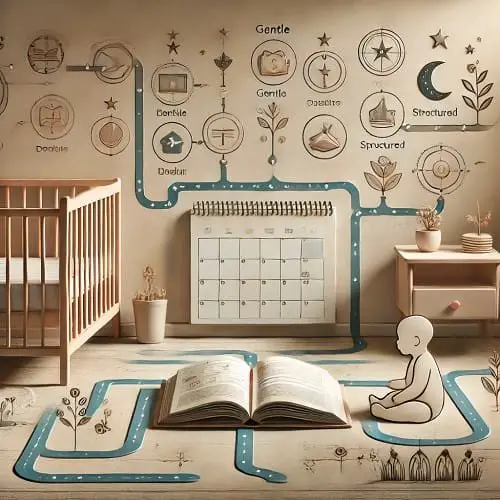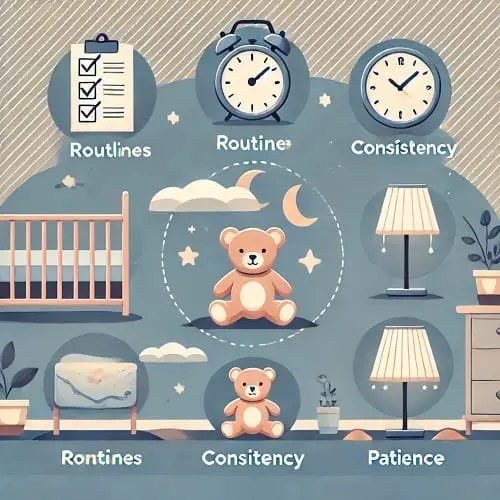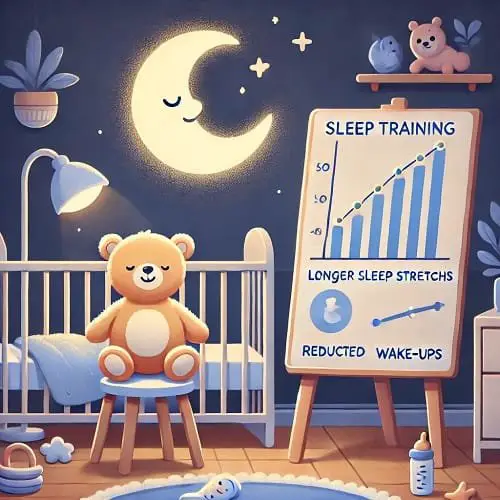1. Introduction
For many parents, sleepless nights become a familiar part of early parenthood. The cries of a restless baby at midnight, the endless rocking, and the lack of proper rest can leave parents feeling physically and emotionally drained. This is where sleep training methods come into play, offering a solution to establish healthy sleep routines and restore balance to the family’s life.
Sleep training refers to the process of teaching your baby how to fall asleep and stay asleep independently. By aligning with your baby’s natural baby sleep schedule, sleep training fosters consistency and structure that benefits both the child and the parents. The importance of sleep training extends beyond just quiet nights—it improves the overall well-being of the family by ensuring everyone gets the rest they need.
However, one question often looms large in the minds of parents: “How long does sleep training take?” The answer to this question varies depending on several factors, such as the method used, the child’s age, and their unique temperament. Knowing how long does sleep training take can help parents set realistic expectations and approach the process with confidence.
In this article, we’ll explore how long does sleep training take for various methods, timelines, and tips to make the process easier. Rest assured, with the right approach and perseverance, peaceful nights are well within reach.
Table of Contents
- 1. Introduction
- 2. What Is Sleep Training?
- 3. Factors Influencing How Long Sleep Training Takes
- 4. Sleep Training Methods and Their Timelines
- 5. Tips for Successful Sleep Training
- 6. Signs Sleep Training Is Working
- 7. Frequently Asked Questions (FAQs)
- 8. Conclusion
2. What Is Sleep Training?

Sleep training is a structured approach to teaching babies how to sleep independently, both at bedtime and when they wake during the night. For many parents, the process is essential to establish healthy infant sleep patterns and ensure the entire family gets adequate rest. The primary goal of sleep training is to foster sleep independence, allowing babies to self-soothe and return to sleep without relying on external help, such as rocking or feeding.
At its core, sleep training addresses the issue of sleep associations—habits or actions babies depend on to fall asleep, like being held or using a pacifier. By addressing these associations, parents can help their child develop skills to sleep more soundly and consistently.
Despite its benefits, there are misconceptions and fears surrounding sleep training. Some parents worry it may harm the parent-child bond or cause undue stress to their baby. However, when done with care and consideration, sleep training can be a positive and transformative experience. It’s important to note that every family’s situation is unique, and the process can be tailored to suit both the baby’s temperament and the parents’ preferences.
There are several popular methods of sleep training, each with its timeline and approach:
- Cry-It-Out Method: Encourages babies to self-soothe by allowing them to cry for short periods before comforting them.
- Ferber Method: A gradual approach that involves progressive intervals of comforting.
- No-Tears Approach: Focuses on gentle techniques that minimize stress for the baby and parents.
Understanding these methods is crucial to answering the key question: “How long does sleep training take?” The duration generally depends on the specific technique used, the child’s readiness to adapt, and the parents’ consistency in following through.
3. Factors Influencing How Long Sleep Training Takes

The question “How long does sleep training take?” doesn’t have a one-size-fits-all answer. The timeline varies widely depending on several factors, including the age of the child, their temperament, the method used, and the consistency of the approach. Understanding these elements can help parents set realistic expectations and tailor their efforts for success.
Age of the Child
The age at which you start sleep training plays a significant role in how quickly results are seen. Newborns typically aren’t ready for structured sleep training, as their sleep cycles are still developing. For infants around 4-6 months, establishing healthy infant sleep patterns becomes more feasible, and results can often be achieved in 1-2 weeks. Older babies or toddlers may take longer, as their existing sleep associations and habits can be harder to change. For parents wondering, “How long does sleep training take?”, the child’s age is often one of the most significant factors.
Child’s Temperament
Every baby is unique, and temperament greatly influences how long sleep training might take. Some children are naturally adaptable and may respond to new bedtime routines quickly. Others, especially those who are more sensitive or strong-willed, may require more time and a gentler approach to adjust.
Consistency
Consistency is a cornerstone of successful sleep training. Parents who adhere to a predictable routine and method often see quicker results. Inconsistent responses, such as sometimes comforting a crying baby and other times letting them self-soothe, can confuse the child and extend the process. This inconsistency can directly impact the answer to the question, “How long does sleep training take?”
Sleep Environment
The sleep environment also impacts how long it takes for sleep training to work. A quiet, dark, and calm space can make it easier for babies to settle and stay asleep. Environmental disruptions, like noise or discomfort, can prolong the process.
Parenting Style and Method
The method chosen can significantly affect the timeline. Techniques like the cry-it-out method often produce quicker results (3-7 days), while gentler approaches like the no-tears method may take several weeks. The choice of method plays a crucial role in determining how long sleep training takes, as some approaches require more time and patience to implement effectively.
By evaluating these factors, parents can better understand how long does sleep training take for their unique situation and approach the process with greater confidence.
4. Sleep Training Methods and Their Timelines

When it comes to sleep training, the method you choose plays a pivotal role in answering the question: “How long does sleep training take?” Different approaches cater to varying parenting styles, babies’ temperaments, and family dynamics. Let’s dive into the most common methods, their timelines, and what makes each unique.
Cry-It-Out Method (3–7 Days)
The cry-it-out method involves allowing your baby to cry without intervention until they learn to self-soothe and fall asleep. This method is one of the quickest ways to establish sleep independence, often taking just 3–7 days.
- Pros: Rapid results; ideal for parents who can stay consistent.
- Cons: Emotionally challenging for some parents; may not suit sensitive babies.
- Best For: Families seeking a fast and effective approach.
For parents wondering, “How long does sleep training take?”, the cry-it-out method is typically one of the shortest timelines.
Ferber Method (7–10 Days)
Also known as the progressive waiting method, the Ferber method involves gradually increasing the intervals between comforting your baby during crying spells. This structured approach allows your baby to adjust more gently to sleeping independently.
- Pros: A balance between quick results and reduced stress for the baby.
- Cons: Requires careful adherence to intervals; can still be emotionally taxing.
- Best For: Parents who want results in a week or two but prefer a less abrupt approach than cry-it-out.
When implemented correctly, the Ferber method often answers the question, “How long does sleep training take?” with a manageable timeline of about a week.
Gentle Sleep Training (2–3 Weeks)
Gentle methods, like gradual sleep training, focus on easing your baby into independent sleeping habits over a few weeks. This might involve staying in the room as your baby falls asleep or gradually reducing your presence.
- Pros: Less crying involved; a compassionate approach for sensitive children.
- Cons: Requires more time and patience; may involve occasional setbacks.
- Best For: Parents who value emotional connection and have the time to invest.
For families using this approach, how long does sleep training take typically extends to 2–3 weeks, but the process is more gradual and less stressful.
No Tears Approach (3+ Weeks)
The no tears approach involves methods like sleep coaching and reinforcing positive associations with sleep without allowing any crying. This method prioritizes emotional security and avoids stress for the baby entirely.
- Pros: Completely avoids distress for both baby and parents.
- Cons: Highly time-intensive; results take longer to achieve.
- Best For: Families with the flexibility and patience for a long-term approach.
When using the no-tears method, how long does sleep training take can stretch beyond three weeks, making it a commitment for families who prioritize a nurturing pace.
Comparison of Timelines
Each method varies in terms of results and emotional involvement. While the cry-it-out method offers the quickest path to success, approaches like gentle sleep training or the no tears approach take more time but provide emotional comfort for both parents and babies.
Ultimately, the timeline depends on the method you choose and your baby’s temperament. Understanding these timelines helps answer the pressing question, “How long does sleep training take?”, and empowers parents to choose what’s best for their family.
5. Tips for Successful Sleep Training

When it comes to ensuring success with sleep training, a thoughtful and consistent approach can make all the difference. Whether you’re following a structured method or taking a flexible approach, these tips will help answer the question, “How long does sleep training take?”, by streamlining the process.
1. Prioritize Consistency in Routines
Consistency is the foundation of effective sleep training. Stick to the same bedtime strategies every night, such as a calming bath, a bedtime story, or gentle cuddles before putting your baby in their crib. Babies thrive on routine, and predictable patterns help them feel secure, making it easier to develop infant sleep patterns. The more consistent you are, the shorter the timeline for results.
2. Practice Patience During Sleep Training
Patience is key, especially during the initial days when progress might feel slow. Remember, how long does sleep training take depends on your baby’s readiness and temperament. Frustration can lead to inconsistencies, which only prolong the process. Stay calm, and remind yourself that each small step forward is progress.
3. Create a Conducive Sleep Environment
A soothing and comfortable setting promotes relaxation and helps your baby fall asleep with ease. Make sure the room is dim, quiet, and pleasantly cool. White noise machines or blackout curtains can help eliminate distractions that might disrupt sleep routines.
ALSO READ
9 Month Sleep Regression: A Parent’s Guide to Navigating Sleep Disruptions
Understanding the 15 Month Sleep Regression: Causes, Solutions, and Expert Insights
4. Avoid Common Mistakes
One of the biggest challenges in sleep training is falling into inconsistent habits, like occasionally rocking your baby back to sleep after deciding on a method. Mixed signals can confuse your baby and lengthen the process, making it harder to determine how long does sleep training take for your family.
5. Address Setbacks and Regressions
It’s normal for setbacks, like illness or developmental milestones, to disrupt progress. When this happens, return to your routine as soon as possible. Troubleshooting sleep training challenges with consistency and positivity will help you regain momentum.
By following these tips and staying consistent, parents can reduce the uncertainty surrounding how long does sleep training take and make the journey smoother. Success often comes down to persistence and trust in the process, ensuring better rest for everyone.
6. Signs Sleep Training Is Working

One of the most encouraging aspects of sleep training is noticing the signs of progress, even if they come in small steps. For parents wondering, “How long does sleep training take?”, these indicators can reassure you that your efforts are paying off.
1. Longer Sleep Stretches
A clear sign that sleep training is working is when your baby begins sleeping for longer stretches at night. Instead of frequent wake-ups, they might sleep for 4–6 hours at a time, or even through the night. These longer sleep stretches indicate that your baby is learning to self-soothe and stay asleep.
2. Reduced Nighttime Wake-Ups
Another positive sign is a noticeable reduction in nighttime wake-ups. While occasional stirring is normal, a trained baby can often put themselves back to sleep without needing your intervention. This progress shows that how long does sleep training take depends on consistent effort, but it yields visible results.
3. Improved Naps
Sleep training benefits daytime routines as well. You may find that your baby’s naps become more predictable, restful, and longer. This consistency contributes to a happy baby who is better rested overall.
4. Baby Falls Asleep Faster
If your baby starts settling down more quickly at bedtime, it’s a strong sign of progress. Establishing sleep routines and reducing dependency on sleep associations often lead to this outcome.
Every baby is different, but these improvements demonstrate that your child is adjusting well to sleep training. Whether gradual or swift, these changes offer hope and encouragement during the process.
7. Frequently Asked Questions (FAQs)
Parents often have pressing concerns about sleep training, and addressing them can help ease doubts and build confidence. Here are answers to some of the most common questions, including insights into “How long does sleep training take?”
1. What’s the Best Age to Start Sleep Training?
The best age for sleep training is usually around 4-6 months. By this age, most babies have developed the ability to sleep for longer stretches and are ready to learn self-soothing techniques. However, every baby is different, so it’s essential to consider your child’s unique development and readiness.
2. Can Sleep Training Harm My Baby Emotionally?
When done correctly, sleep training is not harmful. Concerns often stem from misunderstanding methods like the cry-it-out approach, but research shows that sleep training does not negatively affect a baby’s attachment to parents. Choosing a method that aligns with your parenting style ensures emotional security for your baby.
3. What Should I Do If Sleep Training Isn’t Working?
If you’re not seeing progress, reassess your method and ensure consistency in routines. Common pitfalls include giving in to old habits or lacking a structured approach. It’s also essential to remain patient, as how long does sleep training take varies by baby and method.
4. How Can I Manage Setbacks or Regressions?
Setbacks are normal and can happen during growth spurts, illnesses, or developmental milestones. To manage regressions, stick to your routine as closely as possible and avoid introducing new sleep associations. Over time, your baby will return to their established sleep routines.
By addressing these concerns, parents can approach sleep training with greater clarity and confidence, ensuring the process is as smooth as possible.
8. Conclusion
Sleep training is a transformative journey that offers long-term benefits for both babies and their families. By understanding the factors that influence timelines—such as the method used, your baby’s temperament, and the consistency of routines—you can set realistic expectations about how long does sleep training take and approach the process with confidence.
Every family’s journey is unique, but persistence and patience are key to achieving success. Whether you opt for a structured method like the cry-it-out method or a gradual approach like gentle sleep training, the rewards are well worth the effort. Small victories, such as longer sleep stretches and improved naps, are signs that your efforts are working. Even setbacks are opportunities to learn and grow, making you better equipped to meet your family sleep goals.
Remember, the ultimate reward of successful sleep training isn’t just peaceful nights—it’s the joy of seeing a well-rested baby and parents who are re-energized to tackle each day with positivity. By staying consistent and committed, you’ll create a nurturing environment where sleep becomes a natural and enjoyable part of life.With the right approach and a focus on the end goal, how long does sleep training take becomes less about the timeline and more about the lasting benefits it brings to your family. Peaceful nights are just around the corner!






